Disclosure: Meeple Mountain received a free copy of this product in exchange for an honest, unbiased review. This review is not intended to be an endorsement.
I can only hope you’ve come across the Pixar Theory by now. You know, the one where Boo from Monsters, Inc. grows much older, travels far back through time, and becomes the fateful witch from Brave? In the Pixar Theory, every movie from the celebrated animation studio resides in the same world, connected by a series of winks and nods.
Two things make the theory possible. First is John Ratzenberger, who hovers among the highest grossing Hollywood stars of all time. The beloved Cliff Clavin has had a speaking role in every Pixar movie to date. Everything the man touches turns to gold. One must necessarily cause the other, right? The second thing is the incredible attention to easter eggs across the Pixar catalog. Numbers, signs, corporation names, pizza joints, and 80s sitcom voices. Everything shows up in everything, making just about anything possible when it comes to theorizing.
The tabletop industry could use more winking and nodding, especially when it comes to building stepladders that move players from one level of game complexity to another. I applaud the publishers who have taken to designing little versions of their games. I think it’s fantastic to encourage the kiddos to learn the basics through games like The Kids of Catan and My Little Scythe so they can one day play the more epic originals. But that’s not exactly what I’m talking about.
When I say winking and nodding, I mean connecting titles within a common world à la John Ratzenberger and other less animate easter eggs while still giving every game the opportunity to be its own entity. I do like owning My Lil’ Everdell and all the other Everdell. I would rather own an Everdell-adjacent title that utilizes several of the core concepts, but one that takes place in an orchard several hundred yards away from the Meadow and tells the story of just one of the characters and their wacky extended family. I would love more than a mini.
This long introductory word is to say: Bot Factory from Eagle-Gryphon Games exists with a wink and a nod. Drawing on the design of Vital Lacerda’s Kanban EV, João Quintela Martins has worked with the master to create a distilled and wholly separate factory that makes distinct products while introducing mechanical concepts that will prove invaluable should the players ever find their way to the automotive industry and the more grand title. Then again, perhaps they’ll find enough in the bots that they never see the need to move on.
In Bot Factory, players take to the factory floor to gather plans and parts for robots, build those robots, and manipulate the market surrounding their sale. All this happens in an extremely intuitive and family-friendly format while borrowing the more genius design elements of the other, more complex title in the Sandra-verse, including Sandra herself. May she become the tabletop John Ratzenberger—long live Sandra!
It’s the working
Bot Factory takes place on four connected boards, each representing a function of the factory. The leftmost board is the Assembly board where players contribute tiles featuring bot heads, torsos, and legs. The Part Production board features a spinning wheel that distributes parts as it spins. The Project board is where players collect blueprints required to finish the bots. The Finance Board is where players take on contracts and manipulate the value of each finished bot.
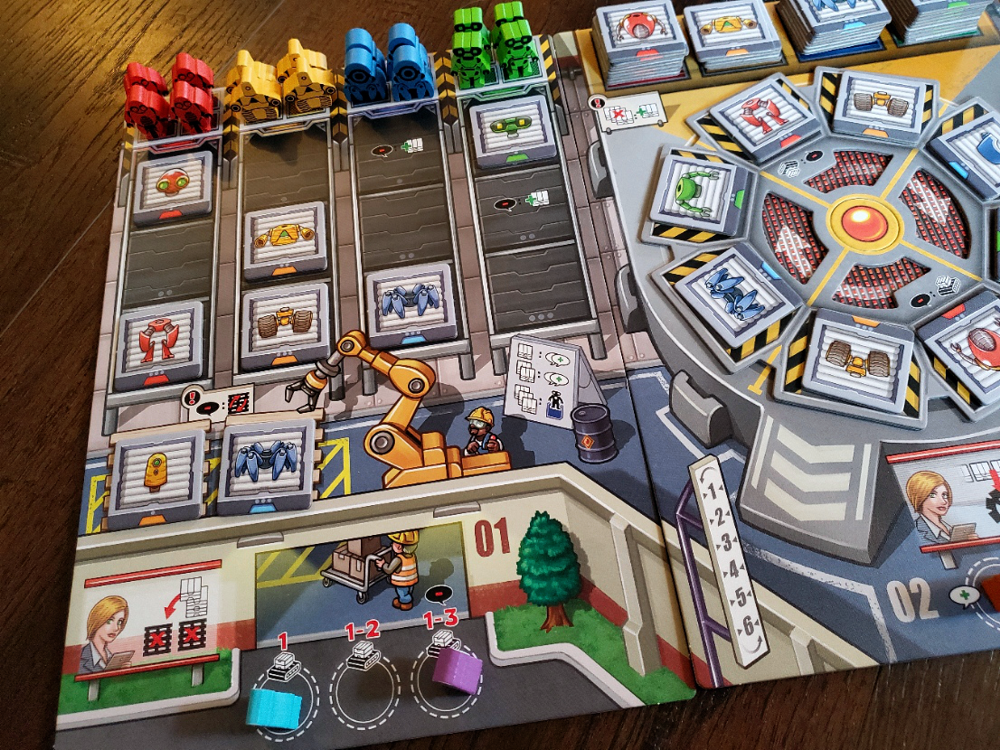
Across the bottom of each board is a series of worker locations that increase in worth from left to right. Each location grants a number of actions on its board. To begin each round, from left to right across the whole factory, players reassign their lone worker to a new location. They can never choose an occupied location, so each player’s decision comes up against an ever-evolving board state. Once the workers are in place, players carry out their actions—again from left to right.
Gumming up the works is Sandra, the consultant hired from the local EV car plant. In each round, taking her place in turn order, she moves to the next available board with an open space. She likewise carries out actions in turn, mostly performing functions of maintenance (She’s far less harshly passionate about bots than she is cars). If ever a player shares a board with Sandra, they must talk to her, spending a Speech Bubble token, the game’s sole currency.
Scattered around the board are various bonus actions that unleash when specific bits and pieces are claimed or put to use. Laying certain bot parts into place in Assembly allows for the purchase of additional parts. Claiming certain bot parts from the Production line opens the door to placing a part, which might unleash the purchase of yet another part. Claiming a blueprint might grant a Speech Bubble or the ability to place a part. All of the bonuses feed combinations that span the width of the factory.

Three of the boards contain an Executive action that is always available in some capacity and doesn’t count against the number of granted actions. Trading parts for parts at 1:1, or 3:1, or trading blueprints for universal (wild) parts equals even more wild combos.
Bot Factory celebrates the tension that comes from shared assembly. There are four colors of robots: red, yellow, blue, and green. Any player can contribute any part to any robot, but only the player who finishes the bot gets the bot. Why would anyone help their opposition? Because the placement of bot parts is the key generator of Speech Bubbles. If you want to do anything else, including manipulate the market, you’ll have to pick and choose the right moments to drop parts somewhere on the assembly line.
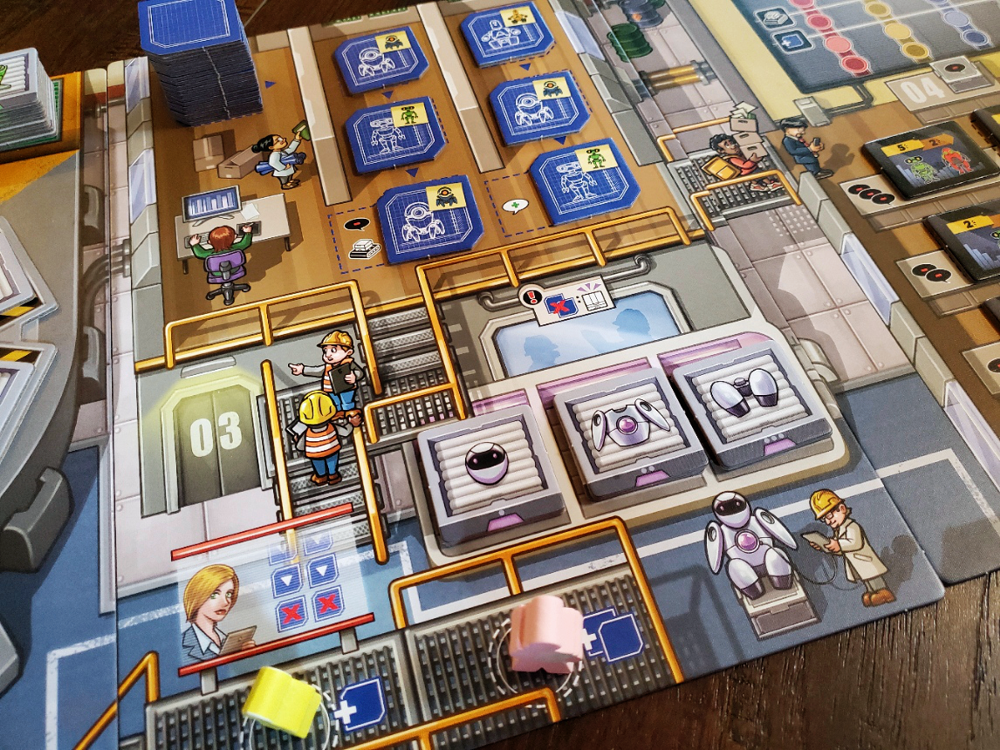
And that market. Every time a bot is finished, its value decreases on the market board. By spending Speech Bubbles on the Finance board, though, players can drive the value up again, unleashing combo-tastic bonuses along the way. Contracts also come by way of the almighty Bubble. Players speculate the robots they’ll have in stock at the end of the game, promising bots or pairs of bots in exchange for endgame points.
When a player has five total bots or the supply (either three or four, depending on the player count) of one bot type is emptied, the game ends. Each bot scores according to its market price. Each contract scores as promised. Unfulfilled contracts result in loss. Extra parts and blueprints are losses as well, while extra Speech Bubbles contribute a pittance to the score. The player with the most points is the winner.
The working
There are two variants included that employ a set of seven Production tiles. These are single-use, game-breaking abilities that decrease costs, raise bot values, or make certain actions more accessible. The difference in the variations is over the means of acquiring the tile. Of the two, I prefer acquisition as a reward for signing the first contract, but with all of the interplay of bonuses, I am quite happy playing without them.
In the solo mode, players face off against Vilela, another clipboard-wielding factory bigwig. I’ve grown to enjoy games that employ a two-tiered approach to solo play. The gateway tier is a task of some sort. In this case, the tasks revolve around production and contract goals that are, to be honest, quite ambitious. Assembling all three bots of one color is no joke! Nor is building three different color bots while driving their values above 12. To fail the task is to be fired—brutally delightful. Success means adding the score to evaluate your performance. In combination, the two tiers make for a deeper and more meaningful solitaire experience.
Just the working life
At this point, if you’ve played Kanban EV, you recognize the similarities. Though I know about Kanban, I’ve not played, so I come into this (I’m guessing) as the target audience.
I learned Bot Factory alongside my nine-year-old son. That alone speaks to the ease with which the game hits the table. I’ve also played with a table of adults, which speaks to the amount of crunch available if you’re into crafting delicious combos. There are several features to the game that make it stand out.
First, the factory moves from right to left while the worker locations resolve from left to right. This simple decision is brilliant. You might be saying, Bob, just move with the factory, it’s not that hard. Ah, but that’s where humanity and Sandra stick their loving wrenches in the plan. In a multi-player affair, it’s just not possible to establish such a rhythm. There are only so many locations on each board. As they fill, plans must change. Plus, knowing where Sandra is (especially in the 2-player game, when you cannot move to the board while she is there) and where she will be is a constant consideration as nobody really wants to spend resources speaking to her.
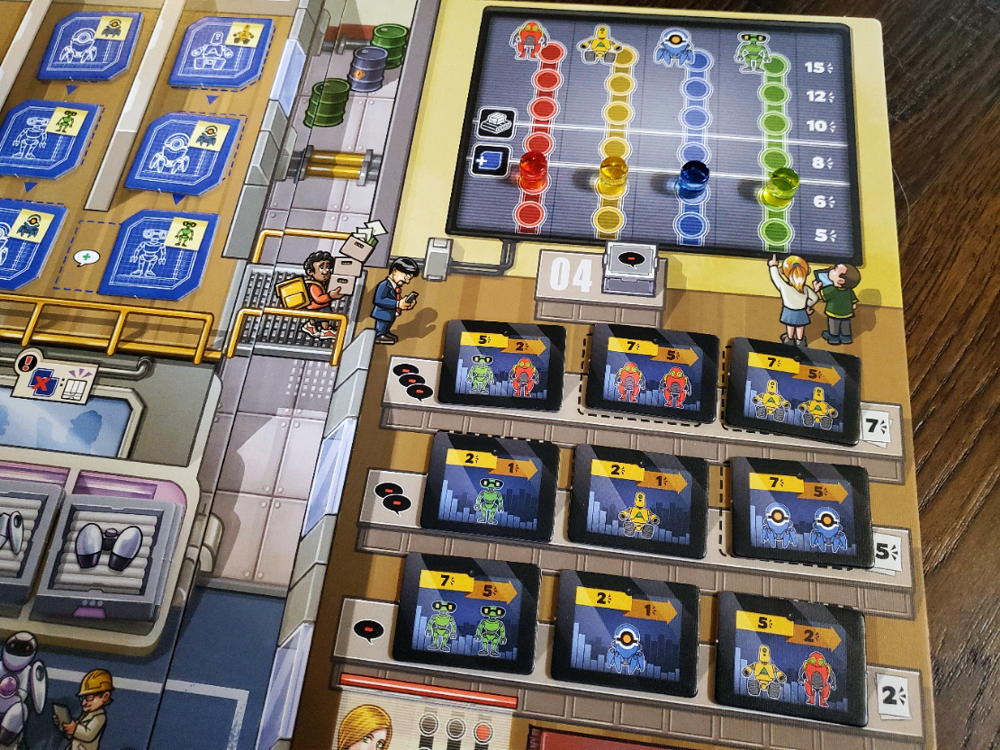
Second, the action queue. This is an extension of the first, but the tension is real in contemplating where to place each worker. Knowing the order in which the spaces will resolve, knowing the current state of each player’s labors, knowing the order in which players will select their upcoming actions. Everything. Matters. With a table of capable humans, Bot Factory is no passive affair. Everyone is in everyone’s way. Everyone is trying to capitalize on the unwitting gifts of others. Folks can only do so much, and it’s no small task to calculate the way to the top.
Third, again, Sandra. It’s funny. She really doesn’t do all that much when she lands somewhere. She shuffles out some pieces, keeps the board fresh—occasionally the ones you want, but she’s really not vicious. She actually drives up the value of the weakest bots when she visits the Finance board. It’s kinda sweet. But in the two-player games she halts movement, and in the high player games she can be manipulated by players occupying spaces to force her to interfere with the opposition. She’s lovely and frustrating all at once.

Bot Factory comes down to developing a second sight for the big picture. Our first four-player game which is absolutely my preference) was won with a fantastic turn that I never saw coming. I thought I had a path to victory. I was grabbing my last blueprint before heading to the Finance board to drive up my bot values and claim a bonus to lay the last part. Crystal clear. Then my wife unleashed a wicked combo from the Assembly floor, stole the bot out from underneath me, and marched to the winner’s circle. I didn’t think anyone could get the parts, let alone spend them! That’s Bot Factory in a nutshell—the most attuned player wins.
There are a few nitpicks here and there. Maintenance is mostly a breeze. When Sandra visits the Project board, she shuffles out the bottom row of blueprints. During maintenance, the same thing happens again. It feels like a redundancy on a board that already features a lot of sliding and shuffling. Rounds move quickly, especially with two players, so I could do with less handling, but I understand the desire for a steady stream of options.
Also, as I’ve shared, there are a lot of combos to track. Base actions may be restricted to the location’s board, but the bonus actions range all over. It’s helpful to either be exceptionally trusting or have folks narrate their turns until everyone understands just how bonkers some of the sequences can be.

But the mechanisms are clean. If you’re not into combos, you’ll hate it. But if you love disassembling and reassembling possibilities in your head, you’ll be smitten. The tensions are real, but not too painful. The theme is light and playful. There are meaningful decisions lingering everywhere.
Overall, Bot Factory is a winner. The physical production is rock solid, but that’s to be expected from Eagle-Gryphon. The bot meeples are great, and all the tactile bits are satisfying. The wheel on the production board works, though if you go at it like a grizzly bear you’ll send tiles flying about. Occasionally the boards jostle and separate, but it really has a lovely presence on the table. The action in front of every player is easy to track via bot and part colors, and it’s not much of a table hog.
The game is decidedly better with more humans involved. There’s something special in the psychology of it all, trying to figure out where your table mates are headed next. There’s also something special in the corresponding lack of predictability. Folks may avoid Sandra, but then again maybe not. I’ve enjoyed watching the scenarios unfold. If you play with three or four, there’s a lot to celebrate here.
Personally, I’m thrilled that the design and development team pushed bots over cars, unique personality over a mere miniaturized copy of the “big league” title. I’m simultaneously thrilled that they invited Sandra to the party as a liaison of sorts to another circumstance in her world. How charming that folks will know her from her work in two different industries!
I never once felt like I was playing a miniature, being set up for another game, or like the robots were just a bait and switch to get me to buy another box. These bots can definitely hold their own. From everything I can see, there’s room for both factories in a gamer’s collection—there’s room for a Sandra-verse. Whether you ever intend to build a car, though, I think it’s worth grabbing a hard hat to visit the Bot Factory.


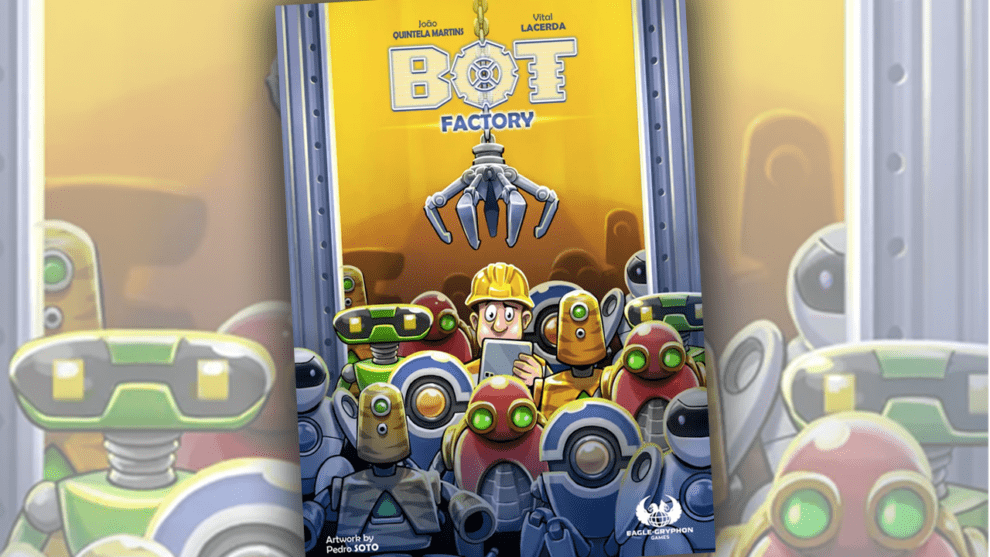



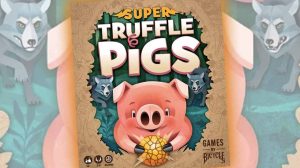
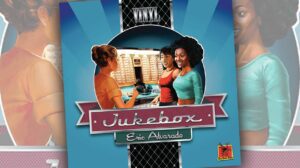




Add Comment